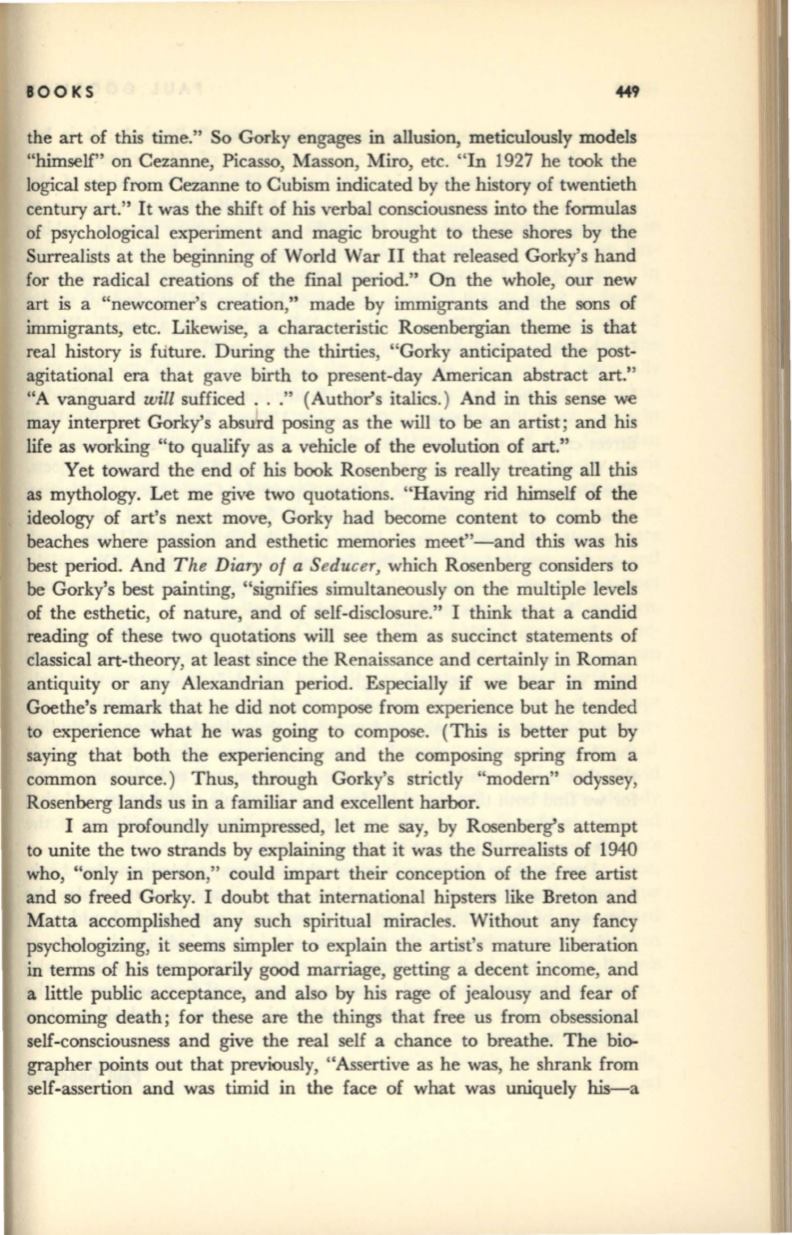
BOOKS
449
the art of this time." So Gorky engages in allusion, meticulously models
"himself" on Cezanne, Picasso, Masson, Miro, etc. "In 1927 he took the
logical step from Cezanne to Cubism indicated by the history of twentieth
century art." It was the shift of his verbal consciousness into the formulas
of psychological experiment and magic brought to these shores by the
Surrealists at the beginning of World War II that released Gorky's hand
for the radical creations of the final period." On the whole, our new
art is a "newcomer's creation," made by immigrants and the sons of
immigrants, etc. Likewise, a characteristic Rosenbergian theme is that
real history is future. During the thirties, "Gorky anticipated the post–
agitational era that gave birth to present-day American abstract
art."
"A vanguard
will
sufficed ..." (Author's italics.) And in this sense we
may interpret Gorky's absu d posing as the will to be an artist; and his
life as working "to qualify as a vehicle of the evolution of
art."
Yet toward the end of his book Rosenberg is really treating all this
as mythology. Let me give two quotations. "Having rid himself of the
ideology of art's next move, Gorky had become content to comb the
beaches where passion and esthetic memories meet"-and this was his
best period. And
The Diary of a Seducer,
which Rosenberg considers to
be Gorky's best painting, "signifies simultaneously on the multiple levels
of the esthetic, of nature, and of self-disclosure." I think that a candid
reading of these two quotations will see them as succinct statements of
classical art-theory, at least since the Renaissance and certainly in Roman
antiquity or any Alexandrian period. Especially if we bear in mind
Goethe's remark that he did not compose from experience but he tended
to experience what he was going to compose. (This is better put by
saying that both the experiencing and the composing spring from a
common source.) Thus, through Gorky'S strictly "modern" odyssey,
Rosenberg lands us in a familiar and excellent harbor.
I am profoundly unimpressed, let me say, by Rosenberg's attempt
to unite the two strands by explaining that it was the Surrealists of 1940
who, "only in person," could impart their conception of the free artist
and so freed Gorky. I doubt that international hipsters like Breton and
Matta accomplished any such spiritual miracles. Without any fancy
psychologizing, it seems simpler to explain the artist's mature liberation
in terms of his temporarily good marriage, getting a decent income, and
a little public acceptance, and also by his rage of jealousy and fear of
oncoming death; for these are the things that free us from obsessional
self-consciousness and give the real self a chance to breathe. The bio–
grapher points out that previously, "Assertive as he was, he shrank from
self-assertion and was timid in the face of what was uniquely his-a


